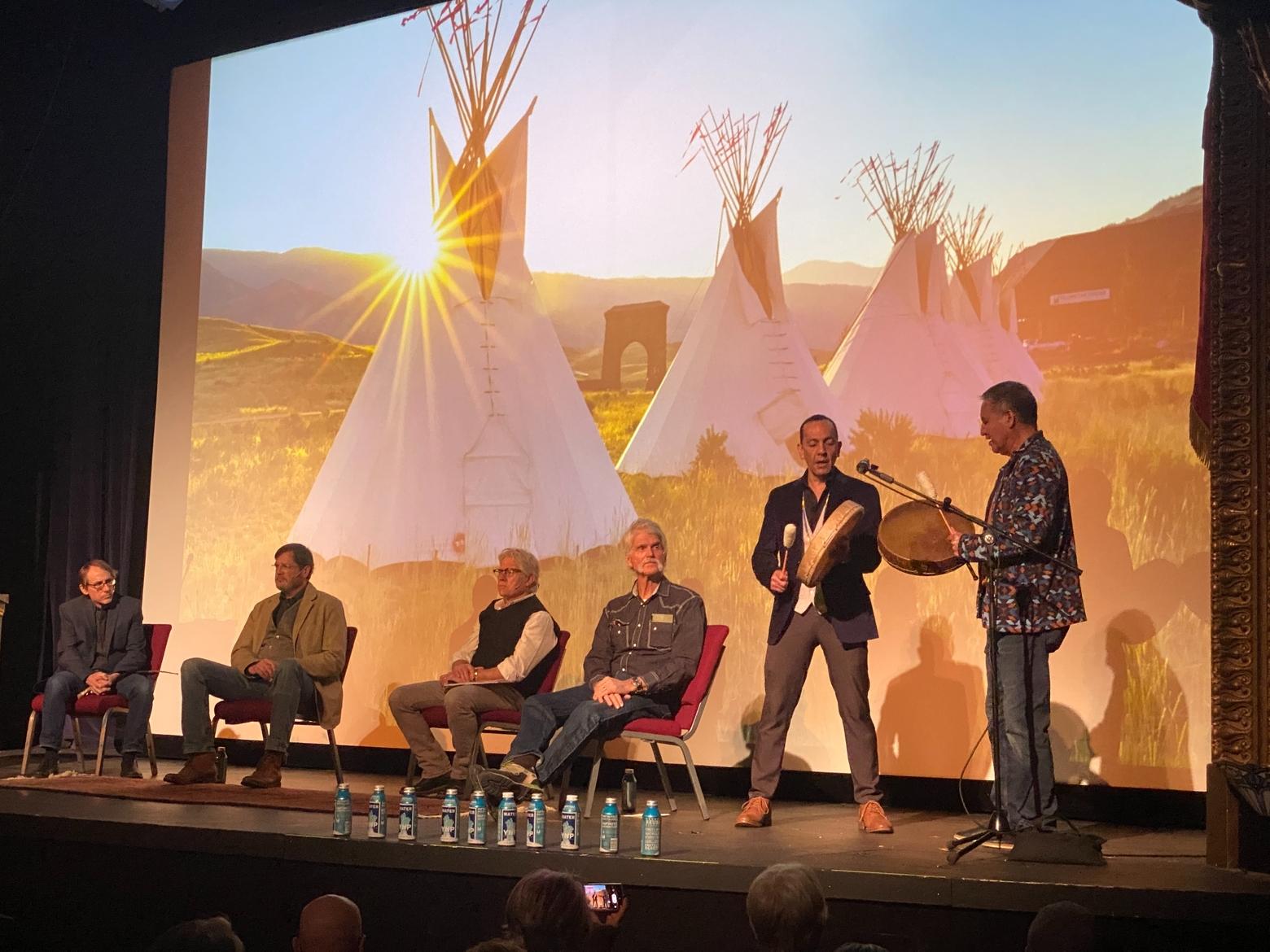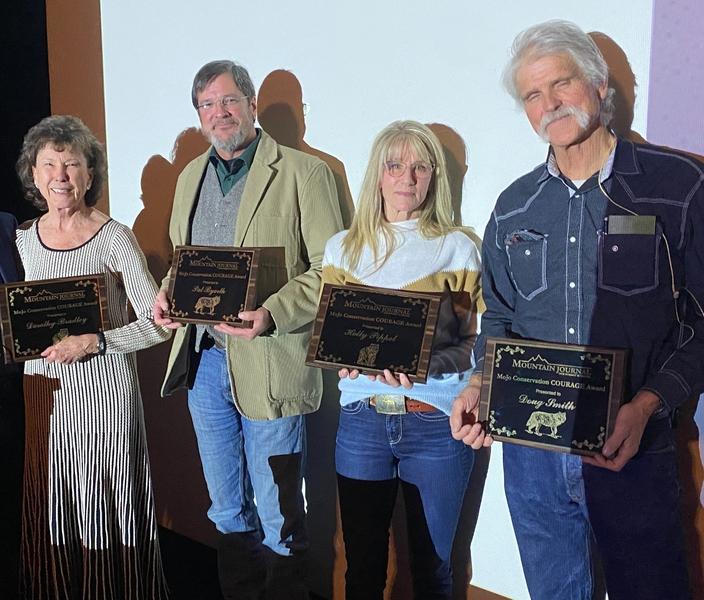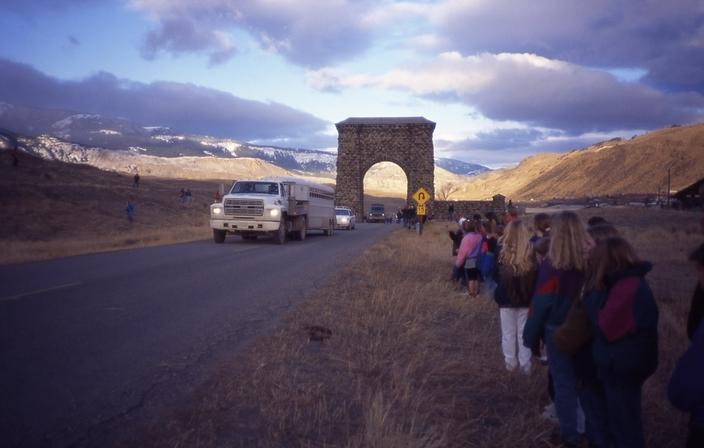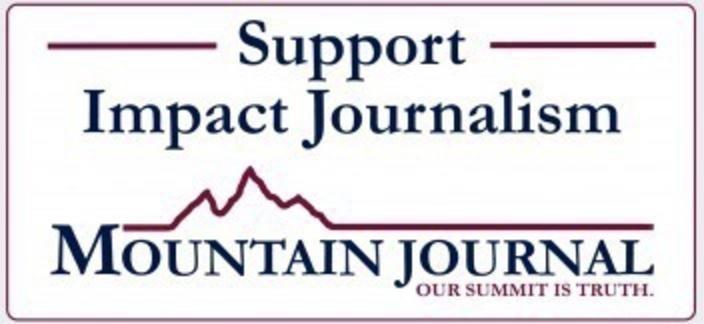Back to Stories'Real' Wolves, Yellowstone and Humans’ Place in the Discussion Revealed at ‘Night of the Wolves’
January 12, 2023
'Real' Wolves, Yellowstone and Humans’ Place in the Discussion Revealed at ‘Night of the Wolves’ MoJo hosts three preeminent wolf experts at The Ellen Theatre, bestows first-ever Conservation Courage awards at sold-out event
by Joseph
T. O’Connor
When Mike
Phillips cupped his hands around his mouth on Jan. 10, 2023 and began to howl,
the theater erupted in a chorus of wolf howls, bringing two storied guests to
the stage for a conversation that won’t soon be forgotten.
The
sold-out event, a Mountain Journal production called “Night of the
Wolves” and hosted at The Ellen Theatre in Bozeman, Montana, featured three
preeminent wolf experts in Greater Yellowstone. They took the stage with MoJo
founder Todd Wilkinson for a conversation about wolves, their critical role in Greater
Yellowstone and the mythology that continues to divide proponents and opponents
of lobos.
What
emerged was a clearer picture of the true wolf. Phillips, a former Montana
senator and representative who served as project leader for the Yellowstone
wolf reintroduction, was joined on stage by Doug Smith, Yellowstone’s chief
wolf biologist for nearly 30 years and Pat Byorth, who recently served on the
Montana Fish and Wildlife Commission. Each has been around the block. Indeed,
Smith was present with Phillips in 1995 when the first eight wolves were
reintroduced into Yellowstone National Park. They studied under L. David Mech,
the foremost wolf biologist on the planet, and as part of the Yellowstone Wolf
Project laid the groundwork for what is now a healthier wolf population in the
area.
In
addition to the main event, Mountain Journal brought to the stage a
number of prominent members of the conservation community. Wilkinson and new MoJo Executive Director Jessie Wiese presented the organization's first
Conservation Courage awards, recognizing Smith and Byorth for their many
contributions to the world of conservation, but also citizen-photographer Holly
Pippel, who has been documenting elk and wildlife near her home in Gallatin
Gateway through powerful imagery, and Dorothy Bradley, who served in the state
Legislature for eight terms, taught at Montana State University, and has worked
tirelessly in her career on water issues and in Indigenous communities.
The
nonprofit conservation journalism group also honored fine-art painter and
illustrator John Potter, a MoJo contributing cartoonist who was present
at the ’95 wolf reintroduction and at the time offered a prayer for wolves and
bison in the Lamar Valley.
Then,
Conrad Fisher of the Northern
Cheyenne/Tsėhéstáno and his nephew Shane Doyle, who sits on the MoJo
board, led two ancient songs honoring Smith, Byorth and wolves and were, in
fact, inspired by wolf howls. In his introduction, Fisher talked of the
connection we have to wolves and the earth.
“We call our scouts ‘wolves’ for a reason,” he said. “But
they’re also part of our cultural institutions … they’re imbued in almost
everything we do.”
The
conversation itself on stage was far reaching but a theme emerged that wove its
way through the entire evening: perception.
“We want
to get at the real wolf tonight,” Wilkinson began. “Not the fabricated wolf.
Not the wolf that flies across the landscape on angels’ wings nor the one that
is the incarnation of the devil.”
Laying the
groundwork for the conversation was critical, Wilkinson said.
Wolves
have never attacked a human being in Yellowstone National Park, Smith noted,
adding that while some wolves have become habituated in the tri-state area of
Montana, Wyoming and Idaho, and the park has put down two wolves since 1995, no
one has ever been hurt.
“There
have been no fatalities and no injuries in Yellowstone,” said Smith, listing
the Northern Rockies and Great Lakes states as further examples. Myths also
abound that wolves kill a large number of cattle and sheep. According to data
from the U.S. Fish and Wildlife Service, annual livestock depredation in the
States due to wolves is between .02 and .03 percent of available livestock.
In terms
of wildlife populations, wolves have never eliminated a
species, Byorth told the crowd, adding that elk numbers in Montana, for example, sit at approximately 94,000.
“Elk
populations haven’t dwindled," Byorth said. "Elk populations like most wildlife populations
are set by habitat. We’ve had a couple districts where wolves have had a
profound impact in terms of changing distribution and changing numbers, but
even those districts alongside Glacier or Yellowstone parks, those elk
populations are at what was considered an objective that was established back
in 2005.”
“[We’ve] stated the data, but data doesn’t win our battles. It’s perceptions [and] feelings and when those folks out there are feeling they’re not being listened to." – Doug Smith, former chief wolf biologist, Yellowstone National Park
Byorth
also called up data from 2019 looking at wolf depredations in Montana when they
killed 50 cattle and 25 sheep. That year, he said, 75 wolves were removed from
the population to balance out the numbers.
The
panelists recognized that wolves can create issues for some ranchers but, as
Phillips pointed out, they are not the main driver of a successful or
unsuccessful operation.
“Insofar
as ranching is concerned,” Phillips said, “there are many things that drive the
industry: bad weather, bad luck, bad marriages, bad kids, bad finances. Gray
wolves don’t drive the industry. Gray wolves can cause a problem on occasion
for individual producers, and that is something to take seriously.”
Smith took
it a step further, empathizing with folks on the ground. “When you are that
rancher, when you are that hunter, they feel that wolves have been foisted on
them: they are another mouth to feed, they are another predator, they do things
to wildlife behavior, they do kill them. So, in their minds, that’s a significant
effect,” he said. “[We’ve] stated the data, but data doesn’t win our battles.
It’s perceptions [and] feelings and when those folks out there are feeling
they’re not being listened to. Yeah, I’m a wolf advocate … but I’ve changed my
stance a little bit to say, ‘what can we get that’s reasonable?” Not everyone
is going to get what they want …but managing with both groups in mind is the
way forward.”
Byorth
brought up that ranchers are financially compensated for livestock predation,
but said it means more than just a check. “Ranchers and wool growers are deeply
concerned about their livestock,” he said. “They’re not quite pets, but they’re
not just an economic force. It’s a very personal thing when the livestock that
you take care of day in and day out is taken away from you by something as
emotional as a wolf predation.”
"Elk populations like most wildlife populations are set by habitat. We’ve had a couple districts where wolves have had a profound impact in terms of changing distribution and changing numbers, but even those districts alongside Glacier or Yellowstone parks, those elk populations are at what was considered an objective that was established back in 2005.” – Pat Byorth, former Fish and Wildlife commissioner
The
conversation lasted about two hours, though the discussion about wolves is
ongoing. It may never be simple but understanding where each side is coming
from, and when arguments are based in fact, we can empathize and have
straightforward discussions about the topic. As Byorth mentioned in quoting
Aldo Leopold during the event, “The art of intelligent tinkering is maintaining
all the parts.”
When the
night began, Wilkinson spoke of the rights we have in Yellowstone and the luck
we in this area have to be a part of this special landscape. “Think about how
lucky we are to be here. We’re here with wolves back in Yellowstone National
Park,” he said. “All of us are stakeholders in Yellowstone. It is a national
treasure. It belongs to us as citizens; it’s part of our birthright.”
At the end
of the evening, after the MoJo Courage awards were handed out, Dorothy
Bradley took the podium to speak about the responsibility we have and the
courage it takes to stand up for the planet and its wild lands and wildlife.
“I find
that the question most frequently asked today is whether I have hope … that our
planet can survive,” Bradley said. “My answer is: Wrong question. It’s simply a
matter of a job to be done and I would rather fight then watch. As would you.
But I want you to know that every one of us is absolutely essential.”
Stay tuned to MoJo: We'll be posting some of the best snippets of the "Night of the Wolves" conversation in the coming days.
Did you find this story worthwhile and interesting? Mountain Journal offers content like this you won't find anywhere else. And while we offer it to you free, not charging hefty subscriptions or putting our stories behind an annoying paywall, we rely upon reader support to keep us going as a non-profit journalist watchdog of the most iconic wildlife-rich ecosystem in America with Yellowstone as its heart. We are profoundly grateful for your generous ongoing support. It allows us to get more reporters in the field covering the things important to you.








